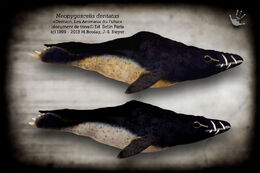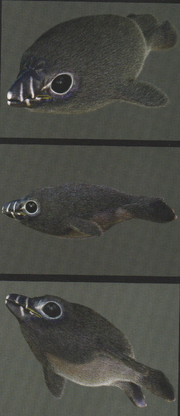
A couple of Neopygoscelis dentatus
Systematic: Aves (Bird), Sphenisciformes (group of Southern Hemisphere seabirds) sphéniscidé (Penguin Group and penguins), Neopygoscelis.
Etymology: from the Latin "neo" and new "pygoscelis" name of the kind of penguin. The name "dentate" refers to the toothed beak of the species.
Cousins of the 21st century: The penguin Adelie, Pygoscelis adeliae. Excellent diver, this is the most abundant penguins. We pushed to the "extreme" its marine lifestyle imagining a half-armed and half-body ichthyosaur
Distribution: Southern Hemisphere, Russell Sea.

On top male and female at the bottom.
Size: 5 meters long for males and 4 meters longs for females.
Morphology: The color is gray in young, black and white adults. Given the amazing marine adaptations that already has the penguin we know (fusiform body, oar-like wings ...), this penguin future we seemed almost obvious. Neopygoscelis has, too, a hydrodynamic body with hind legs turned into oars. Four to five times greater than our penguin, he did not set foot on the ground and it became ovoviviparous (the embryo develops into an egg that hatches into the mother's body).


Baby Neopygocelis dentatus
Neopygoscelis is a champion of apnea and diving (4000 meters deep to 2:30 apnea). He owes his hemoglobin that has a particular structure capable of supplying organs even at low blood concentration of dioxygen; feathers, dense and short, form a hydrophobic wetsuit; the body is protected from the cold waters by a thin layer of fat. It has a hyperdense structure of the skull bones which allows the animal to dive faster and easier to cash pressure and has a kind of capillary net (named "retia mirabilia") that feeds the brain, heart and fins, thus improving respiratory exchanges in these bodies condition shortage dioxygen (as possess the cetacean (beaked whales) and pinnipeds).
As the current whale, Neopygoscelis lowers the temperature of the "melon" (the ball of fat he has on the back), making it more solid and heavier to dive faster; he secret of "oil" organic lining the lungs to better store nitrogen and minimize the risks associated with this gas. It can also exhale all air from the lung. Other unique features: its beak possesses teeth.
Ecolologie: Neopygoscelis feeds mainly on cephalopods (like Ichthyosepia muttereri). It has replaced cetaceans in the pelagic zone and dives regularly hunt (in duet) of large prey.
Reproduction: Neopygoscelis lives in torque (not bench as his older cousin the penguin). The couple went into temperate waters. After mating, the male stores food in his esophagus and the couple migrates to the cold waters. The female gives birth to only one chick (50 cm and 20kg). It is the father who supports the baby: before teaching him to hunt, he feeds by regurgitating esophageal juice very nourishing, the famous "milk penguin", as were his cousins. The growth of the young is fast: it can reproduce from the age of 4 years. It shall then back north into warmer waters.
Old version of Neopygoscelis dentatus

Old version of Neopygoscelis dentatus
There are no really big difference (size aquatic adaptation, toothed beak and couples hunting) except in color of the animal that makes believe Neopygoscelis formerly was the descendant of the African penguin (Spheniscus demersus).

A couple of Neopygoscelis dentatus hunt a shoal of Rhombosepia gregari.
